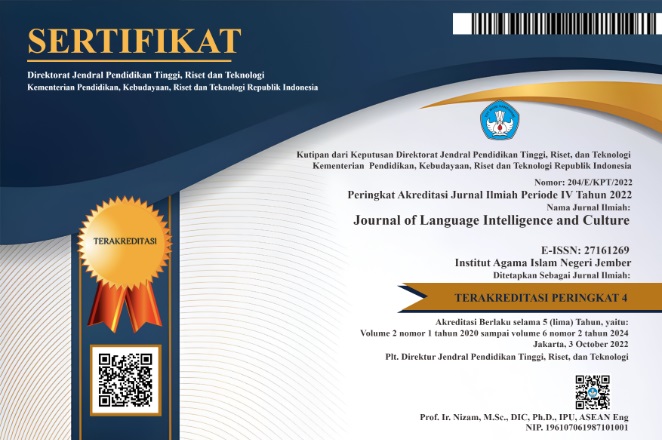Teaching Grammar in Intermediate English Grammar Class: What is Happening beyond the Classroom?
DOI:
https://doi.org/10.35719/jlic.v5i1.125Keywords:
Teaching Grammar, Intermediate ClassAbstract
Teaching grammar is a very complex task to do since the lecturer does not only teach the rules but also teach other aspects of language. As language component, grammar will always play a significant role within the English skills such as listening, speaking, reading, and writing. In relation to this regard, this study exposed the practice of teaching grammar at intermediate grammar class as a part of grammar courses in State University of Malang and seek for the issues of what was happening beyond the classroom which encompassed lecturer’ role, students’ role, classroom management strategy, approach, technique, materials, tasks, language used, lecturer-students interaction, and students’ participation in teaching and learning process. This study used both qualitative and quantitative research approach where the results were described quantitatively in numbers and qualitatively in words describing the phenomena taking place. The results suggested that the teaching and learning process of intermediate grammar at State University of Malang manages to meet almost all of the indicators and criteria within the aspects measured in the observation checklist. The teaching and learning process manages to meet 86.2 % of the indicators which means it meets 50 indicators out of 58. Thus, the teaching ang learning process can be considered as excellent.
References
Abbasian, G.R. &Yekani, N. (2014). The Role of Textual vs. Compound Input Enhancement in Developing Grammar Ability.Academic Research Journal Issues in Language Teaching, (Online), Volume 3, Number 1, 2014 (http://ilt.atu ac.ir/article_1372_332.html, accessed on December 14, 2016).
Ahmad, I. et al. (2012). Teachers’ Perception of Classroom Management Problems and its Solutions; Case of Government Secondary School in Chitral, Khyber Pakhtunkhwa, Pakistan. International Journal of Business and Social Science, (Online), Volume 3, Number 24, 2012 (http://ijbssnet.com/jourals/Vol_3_ No_24_Special_Issue_December_2012/18.pdf, accessed on December 14, 2016).
Bogdan, P. (2011). Student-Centered Learning Environments: How and Why, (Online), (http://www.edutopia.org/blog/student-centered-learning-environment-paul-bogdan), accessed on December 8, 2016.
Brown, H.D. & Lee, H. (2015). Teaching by Principles; An Interactive Approach to Language Pedagogy. United States: Pearson.
Christen, W.L, & Murphy, T.J. (1991). Increasing Comprehension by Activating Prior Knowledge. ERIC Digest, (Online), (http://www/ericdigest.org/pre-9219/prior.htm), accessed on December 20, 2016.
Doyle, W. (1986).Classroom Organization and Management; In M. Wittrock (The 3rd edition).New York: Macmillan.
Harmer, J. (2001). The Practice of English Language Teaching (The 3rd edition). United States: Longman ELT.
Harmer, J. (2007). How to Teach English. Harlow: Pearson Education Limited.
Ho, P.V. & Binh, N.T. (2014). The Effects of Communicative Grammar Teaching on Students’ Achievement of Grammatical Knowledge and Oral Production. English Language Teaching, (Online), Volume 7, Number 6, 2014 (http://www.dx.doi.org/10.5539/elt.v7n6p74, accessed on December 8, 2016).
McLeod, J. et al. (2003). The Key Elements of Classroom Management; Managing Time and Space, Student Behaviour, and Instructional Strategies. Alexandria: ASCD, Association for Supervision and Curriculum Development.
Nahid, Y., Ghalaee, A.F., & Sani, S.Y. (2015). The Effect of Teaching Grammar through Consciousness Raising tasks on high School English Learners’ Grammatical Proficiency. Mediterranean Journal of Social Sciences, (Online), Volume 6, Number 3, 2015 (http://www.mscer.org/journal/index.php/ mjss/article/view/6422/6156, accessed on December 8, 2016).
Nilson, L.B. (2010). Teaching at Its Best: A Research-based Resource for College Instruction. San Fransisco: Jossey-Bass.
Radford, A. (1988). Transformational Grammar: A first Course. Cambridge: Cambridge University Press.
Smithore, V. (2016). Review Strategies: Committing Learning to Long-Term Memory, (Online), (http://www.mi ndtools.com/pages/article/newlSS_05.htm, accessed on December 8, 2016).
Terada, Y. (2015). Review Strategies: Research Trends: Why Homework should be Balanced, (Online), (http://www.edutopia.org/blog/research-trends-is-homowork-effective-youki-terada, accessed on December 1, 2018).
Thronburry, S. (1999). How to Teach Grammar. England: Pearson education Limited.
Ur, P. (1998). Grammar Practice Activities: A Practical Guide for Teachers. Cambridge: Cambridge University Press.
Wu, M. L. et al. (2013). Research on Classroom Management in Taiwanese over the Last Ten years; A Meta Analysis. Asian Journal of Management Science and Education. (Online), Volume 2, Number 3, 2013 (http://www.atlantis-press.com/proceedings/erse-13/7458, accessed on December 8, 2016)
Downloads
Published
How to Cite
Issue
Section
License
Copyright (c) 2023 Giovanni Oktavinanda, Moh. Rofid Fikroni, Juzma Fiatul Umroh

This work is licensed under a Creative Commons Attribution-ShareAlike 4.0 International License.













